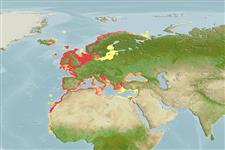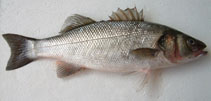Dicentrarchus labrax (Linnaeus, 1758)
European seabass
إضافة ملاحظاتك Fish Watcher
| Native range | All suitable habitat | Point map | Year 2050 |

|
| This map was computer-generated and has not yet been reviewed. |
| Dicentrarchus labrax AquaMaps Data sources: GBIF OBIS |
ارفع صور و مقاطع فيديو
Pictures | Videos | صور قوقلDicentrarchus labrax
Picture by Crocetta, F.
Pictures | Videos | صور قوقلDicentrarchus labrax
Picture by Crocetta, F.
Greece country information
Common names:
Lavraki, Lavráki, Λαυράκι
Occurrence: native
Salinity: freshwater
Abundance: | Ref:
Importance: commercial | Ref: FAO, 1994
Aquaculture: commercial | Ref: FAO Fishery Information, Data and Statistics Service, 1993
Regulations: | Ref:
Uses: no uses
Comments: Recorded from the Messolonghi-Etoliko lagoon system (Ref. 74825). Also recorded from the Strymonikos Gulf (Ref. 74833). Also Ref. 3397.
National Checklist:
Country Information: https://www.cia.gov/library/publications/resources/the-world-factbook/geos/gr.html
National Fisheries Authority:
Occurrences: Occurrences Point map
Main Ref: Papaconstantinou, C., 2014
National Database:
Occurrence: native
Salinity: freshwater
Abundance: | Ref:
Importance: commercial | Ref: FAO, 1994
Aquaculture: commercial | Ref: FAO Fishery Information, Data and Statistics Service, 1993
Regulations: | Ref:
Uses: no uses
Comments: Recorded from the Messolonghi-Etoliko lagoon system (Ref. 74825). Also recorded from the Strymonikos Gulf (Ref. 74833). Also Ref. 3397.
National Checklist:
Country Information: https://www.cia.gov/library/publications/resources/the-world-factbook/geos/gr.html
National Fisheries Authority:
Occurrences: Occurrences Point map
Main Ref: Papaconstantinou, C., 2014
National Database:
Common names from other countries
التصنيف / Names الأسماء الشائعة | مرادفات | Catalog of Fishes(جنس, الانواع) | ITIS | CoL | WoRMS | Cloffa
> Eupercaria/misc (Various families in series Eupercaria) > Moronidae (Temperate basses)
Etymology: Dicentrarchus: Greek, di = two + Greek, kentron = sting + Greek, archos = anus (Ref. 45335).
More on author: Linnaeus.
Etymology: Dicentrarchus: Greek, di = two + Greek, kentron = sting + Greek, archos = anus (Ref. 45335).
More on author: Linnaeus.
Environment: milieu / climate zone / depth range / distribution range البيئة
بحري; المياه العذبة; مياه مخلوطة القاع; محيطية; نطاق العمق 10 - 100 m (Ref. 9987). Subtropical; 8°C - 24°C (Ref. 4944); 72°N - 11°N, 19°W - 42°E (Ref. 54221)
التوزيع دول | مناطق الفاو | النظام البيئي | الظهور | Point map | مقدمة | Faunafri
Eastern Atlantic: Norway to Morocco, the Canary Islands and Senegal. Also known from the Mediterranean and Black Sea. Absent from White, Barents, Baltic and Caspian Seas (Ref. 59043).
Length at first maturity / الحجم / وزن / العمر
Maturity: Lm 36.1, range 23 - 46 cm
Max length : 103 cm TL ذكر/ مختلط الجنس; (Ref. 40637); common length : 50.0 cm TL ذكر/ مختلط الجنس; (Ref. 6916); أعلا وزن تم نشرة: 12.0 kg (Ref. 1468); العمر: 30 سنين (Ref. 59043)
Max length : 103 cm TL ذكر/ مختلط الجنس; (Ref. 40637); common length : 50.0 cm TL ذكر/ مختلط الجنس; (Ref. 6916); أعلا وزن تم نشرة: 12.0 kg (Ref. 1468); العمر: 30 سنين (Ref. 59043)
وصف مختصر مفاتيح التعريف | الوصف الخارجي | قياسات المظهر الخارجي
الأشواك الظهرية (المجموع) : 8 - 10; الأشعة الظهرية الناعمة (المجموع) : 12 - 13; شوكة شرجية: 3; أشعه شرجية لينه: 10 - 12. Diagnosis: head with cycloid scales above; mouth moderately protractile (Ref. 231). Vomerine teeth only anteriorly (Ref. 231), in a crescentic band (Ref. 231, 57391). Scales on interorbital space cycloid (Ref. 57391). Posterior edge of opercle finely serrated, lower edge with strong forward- directed denticles (Ref. 231). 2 flat opercular spines (Ref. 231, 57391). Young with some dark spots on upper part of body (Ref. 231).
Adults manifest demersal behavior, inhabit coastal waters down to about 100 m depth but more common in shallow waters (Ref. 54221, 57391). Found in the littoral zone on various kinds of bottoms on estuaries, lagoons and occasionally rivers. They enter coastal waters and river mouths in summer, but migrate offshore in colder weather and occur in deep water during winter in the northern range. Young fish form school, but adults appear to be less gregarious (Ref. 9987). Feed chiefly on shrimps and mollusks, also on fishes (Ref. 5990). Juveniles feed on invertebrates, taking increasingly more fish with age. Adults piscivorous . (Ref. 59043). Spawn in batches (Ref. 51846). Spawning takes place in the spring near the British Isles, and earlier in its southern range. Eggs are pelagic (Ref. 35388). Marketed fresh or smoked (Ref. 9987). Highly sought by sport fishermen (Ref. 30578).
Life cycle and mating behavior النضج | التكاثر | وضع البيض | بيض | الخصوبة | Larvae
Spawn in groups. Eggs are pelagic. In the Mediterranean, first sexual maturity occurs generally between 2 and 4 years of age while in the Atlantic sexual maturity happens a little later (males between 4-7 years and females between 5-8 years). Spawning happens just once a year and it tends to be in winter, although in southern areas it can occur in spring. Eggs have 1-2 fat drops that fuse about 12 hours after laying. Embryo development lasts about three days at 13-14°C and larval development about 40 days at 19°C. Egg size 1.1-1.5 mm, larval length at hatching 3 mm.
المرجع الرئيسي
Upload your references | مراجع | المنظم : Heemstra, Phillip C. | المتعاونين
Smith, C.L., 1990. Moronidae. p. 692-694. In J.C. Quero, J.C. Hureau, C. Karrer, A. Post and L. Saldanha (eds.) Check-list of the fishes of the eastern tropical Atlantic (CLOFETA). JNICT, Lisbon; SEI, Paris; and UNESCO, Paris. Vol. 2. (Ref. 6916)
IUCN Red List Status (Ref. 130435: Version 2024-2)
قريب من التهديد بالخطر (NT) (Near Threatened); Date assessed: 03 March 2022
خطر للأنسان
Harmless
استخدامات بشرية
مصائد: تجاري; الأستزراع المائي: تجاري; لعبة سمكه: نعم
FAO(Aquaculture systems: الأنتاج, ملف الأنواع; مصائد: الأنتاج, ملف الأنواع; publication : search) | FishSource | البحر حولنا
مزيد من المعلومات
Population dynamics
معاملات النمو
Max. ages / sizes
Length-weight rel.
Length-length rel.
الطول- الترددات
Mass conversion
توظيف
الوفرة
معاملات النمو
Max. ages / sizes
Length-weight rel.
Length-length rel.
الطول- الترددات
Mass conversion
توظيف
الوفرة
Life cycle
التكاثر
النضج
الخصوبة
وضع البيض
Spawning aggregations
بيض
تطور البيضة
Larvae
حركة انتقال اليرقات
التكاثر
النضج
الخصوبة
وضع البيض
Spawning aggregations
بيض
تطور البيضة
Larvae
حركة انتقال اليرقات
Physiology
Body composition
Nutrients
استهلاك الأوكسجين
نوع السباحة
سرعة السباحة
Visual pigments
Fish sound
Diseases & Parasites
Toxicity (LC50s)
Body composition
Nutrients
استهلاك الأوكسجين
نوع السباحة
سرعة السباحة
Visual pigments
Fish sound
Diseases & Parasites
Toxicity (LC50s)
Human related
Aquaculture systems
ملامح تربية الأحياء المائية
سلالات
Ciguatera cases
Stamps, coins, misc.
Aquaculture systems
ملامح تربية الأحياء المائية
سلالات
Ciguatera cases
Stamps, coins, misc.
أدوات
E-book | دليل الميدان | مفاتيح التعريف | Length-frequency wizard | أداة تاريخ الحياة | نقطة علي الخريطة | Classification Tree
| Catch-MSY |
تقارير خاصة
البحث عن صيانت الأحواض المائيه | التحقق من وجود صفحات حقائق الأنواع | البحث عنا حقائق حول الأحواض المائيه
Download XML
مصادر علي الأنترنت
Alien/Invasive Species database | Aquatic Commons | BHL | Cloffa | Websites from users | البحث في مراقبي الأسماك | CISTI | Catalog of Fishes(جنس, الانواع) | DiscoverLife | DORIS | ECOTOX | Faunafri | Fishtrace | GenBank(الوراثة, نيوكلوتيدة) | GloBI | GOBASE | | Google Books | Google Scholar | Google | IGFA World Record | MitoFish | قاعدة البينات الوطنية | OsteoBase(skull, spine) | Otolith Atlas of Taiwan Fishes | احواض مائية عامة | PubMed | Reef Life Survey | Scirus | SeaLifeBase | شجرة الحياة | Wikipedia(ذهب, بحث) | World Records Freshwater Fishing | سجلات علم الحيوانات
Estimates based on models
Preferred temperature (Ref. 115969): 7.3 - 19.5, mean 10.7 (based on 788 cells).
Phylogenetic diversity index (Ref. 82804): PD50 = 0.7656 [Uniqueness, from 0.5 = low to 2.0 = high].
Bayesian length-weight: a=0.00933 (0.00780 - 0.01117), b=3.02 (2.97 - 3.07), in cm Total Length, based on LWR estimates for this species (Ref. 93245).
مستوى غذائي (Ref. 69278): 3.5 ±0.50 se; based on food items.
المرونه (Ref. 120179): وسيط, الحد الزمني الأدني لتضاعف عدد أفراد المجتمع 1.4-4.4 سنة (K=0.06-0.33; tm=2-8; tmax=30; Fec=230,000).
Prior r = 0.37, 95% CL = 0.25 - 0.56, Based on 10 full stock assessments.
Fishing Vulnerability (Ref. 59153): High to very high vulnerability (66 of 100).
Climate Vulnerability (Ref. 125649): Moderate to high vulnerability (47 of 100).




